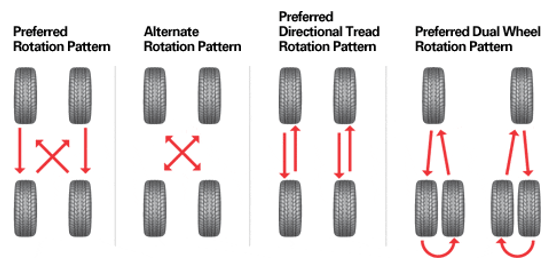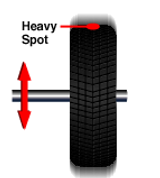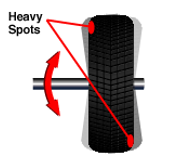Is tire rotation a new concept for you or something that you would like to learn more about? Essentially, tire rotation and balancing is an essential part of your car’s maintenance and will prevent considerable damage. You do not need to be an expert to understand these processes. This article will guide you through the basics of tire rotation and balancing.
Tire Rotation
Why is it important to rotate your tires
Tire rotation is part of your vehicle’s basic maintenance. Regular rotation will expand the life of your tires, improve their performance, and increase the overall safety of your vehicle. Without rotating you will experience poor performance and unnecessarily spend more money than needed in repairs or new tires.
As you drive your tires get worn differently, the front two tires will wear down much faster than those in the back. The front wheels do a majority of the breaking and all of the power transfer, causing them to wear easily. Also, the car’s engine is heavy and located in the front of the car which adds more weight that the front tires must support. The wear of your tires will also differ depending on how you drive and what you drive over. All of these factors impact the wear of your tires, in addition to constant steering, turns, and breaking.
Through regular rotation you will be equalizing the wear of your tires and maximizing the traction of each wheel. The wear of each tire will be even, enabling you to get more miles out of them before buying a new set of tires. One of the most important benefits when it comes to rotating your tires is that the safety of your vehicle will increase. With rotated tires you will have a better handle on the road and will be able to much more safely make a sudden turn or stop. You will also be able to get more miles out of each tire before they need to be replaced, saving you more money. Furthermore, you will have a much smoother ride, increased traction, and improved gas mileage.
How often should you rotate your tires
As with any type of maintenance, manufacturers have different recommendations based on the make and model of the car. If you have the manual and specifications that came with your car always consult them when possible. However, if you are unable to find these specifications, there are general rules that you can follow.
It is generally recommended that tires should be rotated every six months or for every 6,000 to 8,000 miles. An easy way to remember is to ask to have your tires rotated after every other oil change.
How do I know when my tires need to be rotated
As tires age, they develop wear problems, making rotating your tires is unavoidable if you want to maintain their health. Ideally you would want to have your tires rotated before noticeable wears appears on them.
Although it is important to regularly rotate your tires before there are visible signs, there are certain things to look out for. Primarily, signs of uneven wear are a clear indicator that you need to rotate your tires, even if it is only one tire that shows excessive wear. You can also have professional maintenance and inspection performed on your vehicle at least once a year that will check the wear of your tires among other things.
How to rotate your car tires
Rotating your tires is a simple and highly important process will only take an hour to complete if you decide to do the procedure yourself. Remember to always check the specifications and provided guidelines that came with your car. This is an important step because manufactures will have different recommendations based on the make and model of the car. Do not worry if you cannot find these things, you can still follow these general rules and successfully rotate the tires on your own.
Check with a tire service professional to look for any misalignment or imbalance before rotation (tire imbalance will be covered later in the article). During the rotation, each tire and wheel will be removed from the vehicle and moved to a different position on the car to ensure that all tires wear evenly through usage and last longer. You will either want to rotate the fires from the front to back and back to front or diagonally (consult the image below for a helpful visual when determining where to move the tires too).
If your tires are specific to one side of the car you will want to rotate them from the front to back, not from side to side. Always refer to the manual for your specific vehicle when possible, especially if you run into any confusion. If you drive a car with tires that are two different sizes, where the front and rear tires are different sizes, you will need to rotate the tires from side to side rather than from front to back. Also, if you have a cheap spare tire you should consider whether you want to incorporate it into your rotation.
The following image shows various tire rotation patterns:

In order to complete this process, you will need the following supplies:
Supplies:
-Lug nut wrench
-Torque wrench
-Car jack
-Jack stands
-Tire crayon (optional)
-Spare tire (if you decided to add it into the rotation)
A lug nut wrench is a useful tool for working on cars and should be owned by anyone who drives a car. This tool is also easy to use and store within your car. A lug nut wrench can be bought for under $20 dollars.
A torque wrench will prevent damage that may occur from accidently over tightening or damaging the wheels. The recommended specifications for torque wrenches can be found in your owner’s manual. A good quality torque wrench can be bought for under $30 dollars and can be easily stored.
A car jack will provide strength and support while getting a vehicle off of the ground. The jack will go under a thin lip of your car, close to the tires. Your car manual will explain exactly where is the safest place to put the jack. A car jack must be rated at a capacity higher than that of your vehicle. Most importantly, you need to know that car jacks should not be used to hold a vehicle in place, this is what jack stands are for. A basic car jack will cost around $20 dollars.
Jack stands will ensure that the car will not fall and injure you while you work. This tool is a must and this process will be very dangerous if you do not use jack stands. As with a car jack, jack stands must be rated at a higher capacity than that of your vehicle. A sturdy pair of jack stands are sold for under $40 dollars.
If you have never used a car jack or jack stands or would like to brush up on the basics then watch the instructional video below:
A tire crayon is essentially a crayon that will let you mark your tires. The usage of a tire crayon is optional, but this will make the process easier as you will not accidently mix up the tires while you rotate them. They can be bought for only a few dollars.
As for the spare tire, carefully consider if you want to use it in your rotation.
Before you begin the process of rotating your tires, make sure that your car is parked on firm, leveled ground. Hills and soft ground are unsafe for this process.
Steps:
1. Put your car in “park” or in “gear” if it is a manual transmission.
2. Set the parking break firmly and turn off the engine.
3. As a precaution, place blocks ahead of the tires to prevent the car from moving.
4. Loosen the lug nuts using the lug nut wrench, but do not completely remove them.
5. Use the jack to raise the car and place on jack stands for stability.
6. Completely loosen the lug nuts.
7. Remove the tires and mark them with the tire crayon for easy identification if you decided to use tire crayons
8. Rotate your tires according to the pattern you wish to follow, such as moving the tires from front to back or diagonally
9. Screw the lug nuts back in with the lug nut wrench, but do not tightly screw them in yet
10. Slowly lower the car to the ground with the car jack
11. Tighten the lug nuts completely with a torque wrench
12. Repeat this process until all of your tires have been rotated
You have just successfully rotated your tires. Remember to make this a regular process regardless if you have a professional rotate your tires for you or if you wish to do so yourself.
Tire Balancing
Why is it important to balance your tires
In addition to rotating your tires regularly, you should balance your tires on a regular basis. Tire balancing is the process of ensuring that all of your tires are supporting an equal amount of weight. If a particular tire is supporting a disproportionate amount of weight in comparison to the others, this tire will wear more. At high speeds, the slightest imbalance in weight can cause the wheel to spin irregularly, damaging the tires. Balancing your tires will prevent this damage, increase their performance, and lifespan. Furthermore, your tires they will spin smoothly at high speeds and wear evenly.
New tires need to be balanced and the balance of tires will change over time. However, balancing will not amend the issues that come with a physically warped and irregular tire. Most mechanical garages, car dealerships, and forward tire ships have tire balance tools.
Different types of imbalance
There are two different types of tire imbalance that can occur they are static and dynamic imbalances.
Static imbalance occurs when a heavy or light section in the tire prevents the tire from rotating evenly. This will cause an up and down motion, or hop.
The following image demonstrates a static imbalance:

A dynamic imbalance occurs when there is an unequal amount of weight on either one or both side’s of the wheel’s lateral centerline. This creates a side to side motion, or wobble.
The following image demonstrates a dynamic imbalance:

How often should you balance your tires
Similarly with tire rotation, balancing your tires should be a part of your car’s regular maintenance. When to balance tires can vary among manufacturer recommendations, but it is generally accepted to have it completed every 12,000 miles or with every other tire rotation.
Tire imbalance is a greater problem for SUV’s and four-wheel-drive trucks, especially if they are frequently driven off-road. In these instances the tires will need to be rebalanced more often. Also, new tires also need to be balanced.
How do I know when my tires need to be balanced
As with tire rotation, you want to have your tires balanced regularly and before any noticeable warning signs appear.
If you have not regularly balanced your tires, you want to check for any wheel vibration in the steering wheel. You can also have professional maintenance and inspection performed on your vehicle at least once a year that will check the wear of your tires among other things.
How to balance your tires
For this process, the wheel will need to be put on a balancer, which centers the wheel and spins it to determine where the weights should go. This tool will spin the wheel at a very high speed to determine where the heaviest point is and signal where and how many weights should be placed to equalize the balance.
Although there are various ways to balance tires on your own, they will not match the precision of a mechanic’s balancing machine. However, if you wish to do the process yourself and save money you will only need to follow a few steps.
In order to complete this process you will need the following supplies:
Supplies:
-Portable wheel balancer
-Wheel weights
-Duct tape or a similar adhesive
-Torque wrench
-Tire crayon
-A car jack and jack stand if the tire is not yet removed from the car
A portable wheel balancer is a tool that will help you accurately balance your tires. This tool will cost about $80 dollars. To ensure precision, do not skimp out and buy a cheap wheel balancer.
Wheel weights are small weights that will be added to each wheel to regulate its weight. The cost of the weights will vary depending on the weights that you need.
Duct tape or a similar adhesive will be used to used to secure the weights.
As stated earlier, a torque wrench will prevent damage that may occur from accidently over tightening or damaging the wheels. The recommended specifications for torque wrenches can be found in your owner’s manual. A good quality torque wrench can be bought for under $30 dollars and can be easily stored.
Unlike with rotating your tires, a tire crayon is not optional. The tire crayon will let you mark your tires. The process of balancing your wheels without the usage of a tire crayon will make things frustrating. Tire crayons can be bought for only a few dollars.
If the tire you wish to work on is not yet removed you will need to use a car jack and jack stand. As stated earlier, a car jack will provide strength and support while getting a vehicle off of the ground. The jack will go under a thin lip of your car, close to the tires. Your car manual will explain exactly where is the safest place to put the jack. A car jack must be rated at a capacity higher than that of your vehicle. A basic car jack will cost around $20 dollars.
It is highly important to understand that car jacks should not be used to hold a vehicle in place, this is what jack stands are for. Jack stands will ensure that the car will not fall and injure you while you work. This tool is a must and this process will be very dangerous if you do not use jack stands. As with a car jack, jack stands must be rated at a higher capacity than that of your vehicle. A sturdy pair of jack stands are sold for under $40 dollars.
Before you begin the process of balancing your tires make sure that your car is parked on firm, leveled ground. You do not want your car to roll away, hills and soft ground are unsafe for this process.
Steps:
1. Put your car in “park” or in “gear” if it is a manual transmission.
2. Set the parking break firmly and turn off the engine.
3. As a precaution place blocks ahead of the tires to prevent the car from moving.
4. Loosen the lug nuts for the tire you plan to work on using the lug nut wrench but do not completely remove them.
5. Use the jack to raise the car and place on jack stands for stability.
6. Completely loosen the lug nuts of the tire you wish to work with.
7. Remove the tire from the car
8. Take off any wheel weights that are already on the wheel. Not removing them will make this process more difficult.
9. Place the tire on the balancer tool through putting the shaft through the wheel hub and security it in place.
10. Make sure that the wheel is well centered on the balancer.
11. Gently spin the wheel on the balancer. The heaviest part of the wheel will tilt towards the ground while the lightest part will be elevated.
12. After the wheel has settled, use the tire crayon to mark the lightest section.
13. Repeat this process once more for accuracy.
14. Apply the wheel weights to the lightest section that you have marked in order to counter the tire’s imbalance.
15. Test the wheel on the balancer and see if the weight is even.
16. Use duct tape or a strong adhesive to secure the weights to the wheel even further. Although wheels come with an adherent, they are not very strong.
17. Remount the wheel to the car, make sure that the lug nuts are secure with a torque wrench
18. Repeat this process until all of your tires have been balanced
You have just successfully balanced your tires. Remember to make this a regular process regardless if you have a professional rotate your tires for you or if you wish to do so yourself.
Overall benefits
Car owners have a great deal to gain from regularly rotating and balancing their tires. These basic maintenance processes are easy to understand and will make even the most inexperienced driver feel capable of taking care of their car.
Through these maintenance processes you will expand the lifetime of your tires. Furthermore, tire rotating and balancing will allow you to enhance the usage of your tires which will save you a great deal of money, as a new set of tires will cost hundreds of dollars. You will have a far safer driving experience and will be able avoid preventable tire accidents. Also, you will be more knowledgeable about your car and able to take action if any problems occur or you choose to have a professional rotate and balance your tires.
If you have any hesitations when it comes to these processes, check your car’s manual and consult with a professional. Working with confidence is key to successfully maintaining your vehicle.
Admire your good work and think about how much money you are saving through basic car maintenance. You may never need to go to a mechanic again for these basic tire problems and become the expert among your family and friends.
